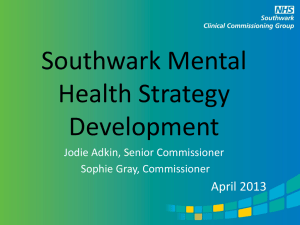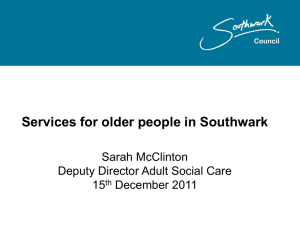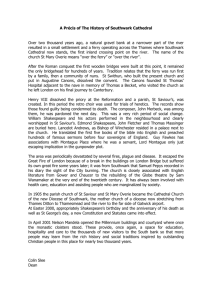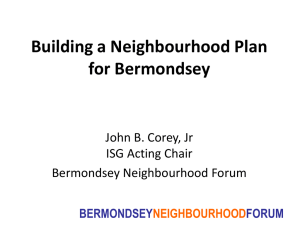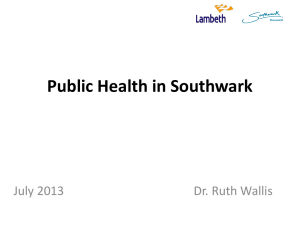Karl Murray
advertisement
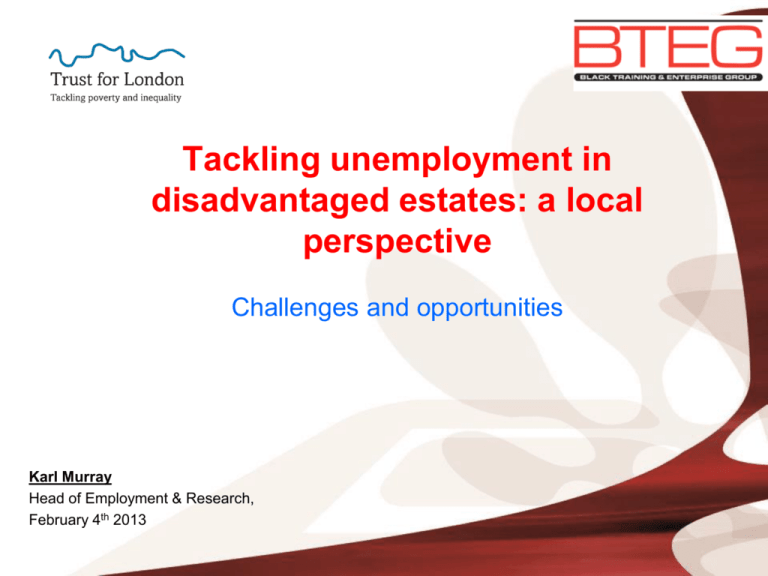
Tackling unemployment in disadvantaged estates: a local perspective Challenges and opportunities Karl Murray Head of Employment & Research, February 4th 2013 Why we thought this was necessary…. “…Nearly half of Britain's young black people are jobless. We've created an inequality time bomb” (Diane Abbot, March 2012) Figures from the Labour Force Survey reveal that unemployment among young black people (aged 16-24) is a shocking 44% – over twice the rate of their white counterparts, of whom 20% are jobless. (The Guardian, March 2012) Unemployment rate: July - Sept'12 18.8 16.0 15.1 13.1 9.9 7.4 Regional and national unemployment rates: London: 8.3% UK: 7.7% Source: ONS, Labour Force Survey, January 23rd 2013 10.9 12.2 Employment rate (%): July - Sept. 2012 73.1 62.3 69.9 62.5 51.3 Regional & national employment rates: London: 69.7% UK: 71.4% Source: ONS, Labour Force Survey, January 23rd 2013 49.3 51.1 60.5 What we tried to find out… 1. To what extent are BME groups being supported to gain employment and/or employment skills? 2. To what extent are local policies and strategies making a difference? Southwark JSA claimants: overview 55% 36% 9% White BAME Source: Claimant count, ONS, cited on LSEO, last updated November 2012 (next update due February 2013) Not specified Southwark JSA claimants (%) by ethnic clusters 41% 36% 9% 5% White Mixed 6% 3% Asian Black Source: Claimant count, ONS, cited on LSEO, last updated November 2012 (next update due February 2013) Chinese & others Not specified Policy drivers - priority groups and barriers to overcome Priority Groups Barriers to Work for priority groups • • • • • • • • • • • • BME groups; Women; Families with young dependents; Lone parents; 18 -24 year olds; Young people not in education, employment, or training (NEET) or at risk of becoming NEET; Residents with physical, mental or learning disabilities; Ex-offenders/young offenders; Residents with alcohol or drug dependency; Homeless people; Refugees; Those over age 50 Limited access to and awareness of services Limited access to ESOL courses Confidence and motivation Lack of affordable and flexible childcare Limited employer participation Poor physical and mental health Family issues and breakdown Limited Basic and Soft Skills Limited vocational skills Benefits trap/dependency Source: Southwark Economic Development Strategy: 2010 – 2016 The Aylesbury estate…. • The Aylesbury was built in the 1960/70s and has 2,758 dwellings accommodating over 7,500 families, with 17% privately owned and only 2% of the dwellings are houses. • The regeneration plan aims to transform the Aylesbury over a 20 year period to provide for a vibrant community living in high quality homes and whose residents enjoy great streets, parks and open spaces, excellent public transport and a wide range of facilities (www.creationtrust.org.uk) • The Aylesbury has a higher than borough average rate of worklessness. The Aylesbury estate (cont’d)…. • The employment rate on the estate is 54.9% compared to the borough average of 62.8; the unemployment rate is 16.3% compared to the borough rate of 10.8% [Nomis, March 2012]; • While much has been achieved in supporting Aylesbury residents into employment, the impact of the recent recession has led to increased unemployment and a changing composition of out of work claimant patterns on the estate with increasing numbers of residents claiming JSA (6.4% compared to the borough’s average of 5.3% and the UK rate of 4.1%) [Nomis, March 2012] • With respect to claimants between the ages of 18 – 24, the Faraday ward has one of the highest rates of claimants across all the wards (25.4% compared with a borough average of 22.3%); only Cathedral ward had higher rate at 26.4% [Nomis, March 2012]. Who did we talk to… • Our analysis was informed by random interviews with 20 BAME individuals; • An on-line survey of 21 respondents; • A workshop of 10 with a focus on unemployed young people jointly facilitated by BTEG, Creation Trust and JCP; • Face to face interviews with policy and programme providers within Creation Trust, AIAG, Southwark Works and Southwark Council. What we found…. Four areas/themes emerged: 1. 2. 3. 4. Barriers to employment De-motivation and despair Skills development and training Access to personal development opportunities. Example 1: Southwark Pop up Shop: young people enterprise… • An initiative with young people aged 18yrs+ to manage a shop in selling products of their choice and open to young people living in Walworth, Camberwell and Faraday wards (adjoining wards). • Project jointly funded/supported by Southwark Council delivered through Creation Trust, a voluntary organisation based on the Aylesbury estate and funded by L&Q • The programme consist of 3wks off-site training and 3wks ‘selling and business delivery’ experience What young people said… What was learnt… – Patience – Market research – Team work “…not what I want but learnt lots from the process” “…challenging self and was able to do something rather than staying home” “ …I now understand better what it takes to run a shop! The profit margin is not great for the outlay but we were lucky as council fronted everything.” “…coping with different attitudes and those not pulling their weight…we did everything including painting and choosing colour scheme. The hard part was trying to buy/source products… That was hard.” Example 2: Back to Business (NEET) Age range: 14 – 18yrs Ethnic breakdown: 71% BAME 23% White 6% Did not specify/missing Gender: 61% Male 39% Female Output • 75 young people have been signed up to the programme and completed an action plan; • 56 young people completed non accredited learning opportunities lasting 2 weeks Example 3: The Aylesbury Information, Advice and Guidance Service… “…we get support to putting CVs together and attend training such as setting up new businesses and get 1:1 advice and support.” “…Opportunities to socialise and off-load frustration is not always possible. To know that you are not alone makes a big difference in how you see yourself and possibilities. These will help you to cope better while striving to make ends meet.” “…Places like JCP does not help you to develop confidence. You are on your own. They show you vacancies and by the time you apply all the jobs have gone. We go on-line and there are so many people applying for the same job. So you feel despondent and frustrated but no one try to help you cope with these; no one cares.” Conclusion, issues and recommendations…. • • Jobseekers reported a wide range of factors affecting their ability to gain employment, many of which corresponds to the barriers identified in the council’s economic development strategy; Some jobseekers identified actions that they felt would increase their prospects: – Providing better careers information and advice about different sectors. – For the long-term unemployed, training opportunities, held in the mornings to encourage the habit of getting up to do something, with opportunities to address health and well-being concerns; – Credible and meaningful training; – Apprenticeships and work trials. The Aylesbury Information, Advice and Guidance Service Dotun Alade-Odumosu Director Al Pafeno CiC 2nd Floor, Wendover House Thurlow Street, London SE17 2UU Tel: 020 7252 7030/020 7701 4141 Email: aylesburyiag@yahoo.co.uk Website: www.aylesburyiag.org.uk For further information Karl Murray Head of Employment and Research Black Training and Enterprise Group (BTEG) 2nd Floor 200a Pentonville Road London N1 9JP Tel: 020 7832 5839 Email: karl@bteg.co.uk Web: www.bteg.co.uk
